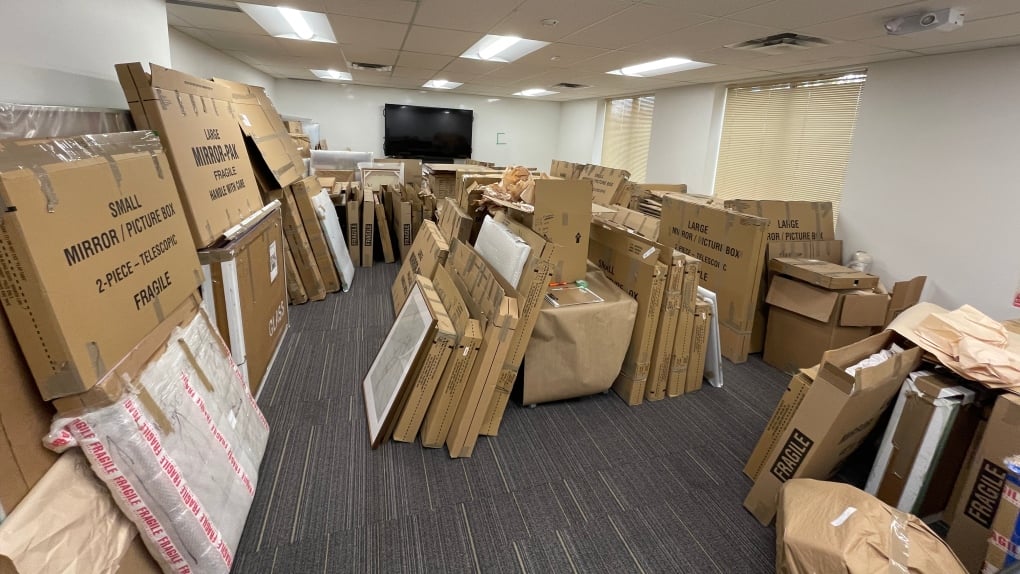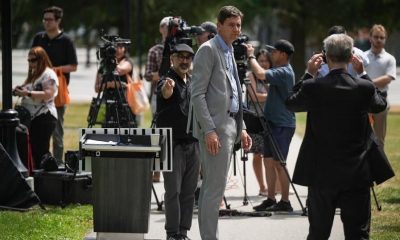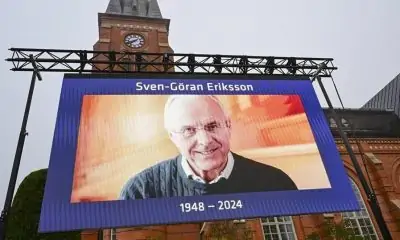Art
The Art of the Lie? The Bigger the Better – The New York Times
Lying as a political tool is hardly new. But a readiness, even enthusiasm, to be deceived has become a driving force in politics around the world, most recently in the United States.
MOSCOW — In a cable to Washington in 1944, George F. Kennan, counselor at the United States Embassy in Stalin’s Moscow, warned of the occult power held by lies, noting that Soviet rule “has proved some strange and disturbing things about human nature.”
Foremost among these, he wrote, is that in the case of many people, “it is possible to make them feel and believe practically anything.” No matter how untrue something might be, he wrote, “for the people who believe it, it becomes true. It attains validity and all the powers of truth.”
Mr. Kennan’s insight, generated by his experience of the Soviet Union, now has a haunting resonance for America, where tens of millions believe a “truth” invented by President Trump: that Joseph R. Biden Jr. lost the November election and became president-elect only through fraud.
Lying as a political tool is hardly new. Niccolo Machiavelli, writing in the 16th century, recommended that a leader try to be honest but lie when telling the truth “would place him at a disadvantage.” People don’t like being lied to, Machiavelli observed, but “one who deceives will always find those who allow themselves to be deceived.”
A readiness, even enthusiasm, to be deceived has in recent years become a driving force in politics around the world, notably in countries like Hungary, Poland, Turkey and the Philippines, all governed by populist leaders adept at shaving the truth or inventing it outright.
Janez Jansa, a right-wing populist who in 2018 became prime minister of Slovenia — the home country of Melania Trump — was quick to embrace Mr. Trump’s lie that he won. Mr. Jansa congratulated him after the November vote, saying “it’s pretty clear that the American people have elected” Mr. Trump and lamenting “facts denying” by the mainstream media.
Even Britain, which regards itself as a bastion of democracy, has fallen prey to transparent but widely believed falsehoods, voting in 2016 to leave the European Union after claims by the pro-Brexit camp that exiting the bloc would mean an extra 350 million pounds, or $440 million, every week for the country’s state health service.

Those who advanced this lie, including the Conservative Party politician who has since become Britain’s prime minister, Boris Johnson, later admitted that it was a “mistake” — though only after they had won the vote.
Bigger and more corrosive lies, ones that don’t just fiddle with figures but reshape reality, have found extraordinary traction in Hungary. There, the populist leader Viktor Orban has cast the financier and philanthropist George Soros, a Hungarian-born Jew, as the shadowy mastermind of a sinister plot to undermine the country’s sovereignty, replace native Hungarians with immigrants and destroy traditional values.
The strength of this anti-Semitic conspiracy theory, said Peter Kreko, executive director of Political Capital, a research group in Budapest long critical of Mr. Orban, lies in its appeal to a “tribal mind-set” that sees all issues as a struggle between “good and evil, black and white,” rooted in the interests of a particular tribe.
“The art of tribal politics is that it shapes reality,” Mr. Kreko said. “Lies become truth and explain everything in simple terms.” And political struggles, he added, “become a war between good and evil that demands unconditional support for the leader of the tribe. If you talk against your own camp you betray it and get expelled from the tribe.”
What makes this so dangerous, Mr. Kreko said, is not just that “tribalism is incompatible with pluralism and democratic politics” but that “tribalism is a natural form of politics: Democracy is a deviation.”
In Poland, the deeply conservative Law and Justice Party of Jaroslaw Kaczynski, in power since 2015, has promoted its own multipurpose, reality-shifting conspiracy theory. It revolves around the party’s repeatedly debunked claim that the 2010 death of scores of senior Polish officials, including Mr. Kaczynski’s brother — Poland’s president at the time — in a plane crash in western Russia was the result of a plot orchestrated by Moscow and aided, or at least covered-up by the party’s rivals in Warsaw.
While Polish, Russian and independent experts have all blamed bad weather and pilot error for the crash, the belief that it was foul play has resonated among die-hard Law and Justice supporters. It has both fed on and reinforced their view that leaders of the previous centrist government are not just political rivals but traitors in cahoots with Poland’s centuries-old foe, Russia, and Poland’s own former communist elite.
The utility of lying on a grand scale was first demonstrated nearly a century ago by leaders like Stalin and Hitler, who coined the term “big lie” in 1925 and rose to power on the lie that Jews were responsible for Germany’s defeat in World War I. For the German and Soviet dictators, lying was not merely a habit or a convenient way of sanding down unwanted facts but an essential tool of government.
It tested and strengthened loyalty by forcing underlings to cheer statements they knew to be false and rallied the support of ordinary people who, Hitler realized, “more readily fall victims to the big lie than the small lie” because, while they might fib in their daily lives about small things, “it would never come into their heads to fabricate colossal untruths.”
By promoting a colossal untruth of his own — that he won a “sacred landslide election victory” — and sticking to it despite scores of court rulings establishing otherwise, Mr. Trump has outraged his political opponents and left even some of his longtime supporters shaking their heads at his mendacity.
In embracing this big lie, however, the president has taken a path that often works — at least in countries without robustly independent legal systems and news media along with other reality checks.
After 20 years in power in Russia, President Vladimir V. Putin, for example, has shown that Mr. Kennan was right when, writing from the Russian capital in 1944, he said, “Here men determine what is true and what is false.”
Many of Mr. Putin’s falsehoods are relatively small, like the claim that journalists who exposed the role of Russia’s security service in poisoning opposition leader Aleksei A. Navalny were working for the C.I.A. Others are not, like his insistence in 2014 that Russian soldiers played no role in the seizure of Crimea from Ukraine, or in fighting in eastern Ukraine. (He later acknowledged that “of course” they were involved in grabbing Crimea.)
But there are differences between the Russian leader and the defeated American one, said Nina Khrushcheva, a professor and expert on Soviet and other forms of propaganda at the New School in New York. “Putin’s lies are not like Trump’s: They are tactical and opportunistic,” she said. “They don’t try to redefine the whole universe. He continues to exist in the real world.”
Despite his open admiration for Russia’s president and the system he presides over, she said, Mr. Trump, in insisting that he won in November, is not so much mimicking Mr. Putin as borrowing more from the age of Stalin, who, after engineering a catastrophic famine that killed millions in the early 1930s, declared that “living has become better, comrades, living has become happier.”
“That is what the big lie is,” Ms. Khrushcheva said. “It covers everything and redefines reality. There are no holes in it. You so either accept the whole thing or everything collapses. And that is what happened to the Soviet Union. It collapsed.”
Whether Mr. Trump’s universe will collapse now that some allies have taken flight and Twitter has snatched his most potent bullhorn for broadcasting falsehoods is an open question. Even after the Capitol siege by pro-Trump rioters, more than 100 members of Congress voted to oppose the election outcome. Many millions still believe him, their faith fortified by social media bubbles that are often as hermetically sealed as Soviet-era propaganda.
“Unlimited control of people’s minds,” Mr. Kennan wrote, depends on “not only the ability to feed them your own propaganda but also to see that no other fellow feeds them any of his.”
In Russia, Hungary and Turkey, the realization that the “other fellow” must not be allowed to offer a rival version of reality has led to a steady squeeze on newspapers, television stations and other outlets out of step with the official line.
President Recep Tayyip Erdogan of Turkey has shut down more than 100 media outlets and, through bullying by the tax police and other state agencies, forced leading newspapers and television channels to transfer ownership to government loyalists.
This assault began in 2008 with claims by Mr. Erdogan and his allies that they had discovered a sprawling underground group of coup plotters and subversives comprising senior military officers, writers, professors, editors and many others.
“The group was completely invented, a total fabrication,” said Soner Cagaptay, director of the Turkish Research Program at the Washington Institute for Near East Policy and author of“The New Sultan: Erdogan and the Crisis of Modern Turkey.”
This big lie, built around a few shards of fact, convinced not only pious Muslims hostile to the country’s secular elite but also liberals, many of whom then viewed the military as the biggest threat to democracy. Trials dragged on for years before Mr. Erdogan acknowledged that the case against the alleged underground group was a sham.
Long before Mr. Trump, Mr. Cagaptay said, the Turkish leader, who has ruled since 2003, “saw the power of nativist and populist politics” rooted in falsehoods and “brought to prominence the idea of the deep state to justify crackdowns on his political opponents.”
Mr. Trump’s ascent also helped empower a cousin of the big lie — a boom in social-media disinformation and far-right conspiracy-theory fiction.
It has most notably been embodied by the global expansion of Qanon, a once-obscure fringe phenomenon that claims the world is run by a cabal of powerful liberal politicians who are sadistic pedophiles. Mr. Trump has not disavowed Qanon disciples, many of whom participated in the Capitol mayhem last Wednesday. In August he praised them as people who “love our country.”
To some extent, each new generation is shocked to learn that leaders lie and that people believe them. “Lying never was more widespread than today. Or more shameless, systematic, and constant,” the Russian-born French philosopher Alexandre Koyré wrote in his 1943 treatise, “Reflections on Lying.”
What most distressed Mr. Koyré, however, was that lies don’t even need to be plausible to work. “On the contrary,” he wrote, “the grosser, the bigger, the cruder the lie, the more readily is it believed and followed.”
Art
Calvin Lucyshyn: Vancouver Island Art Dealer Faces Fraud Charges After Police Seize Millions in Artwork

In a case that has sent shockwaves through the Vancouver Island art community, a local art dealer has been charged with one count of fraud over $5,000. Calvin Lucyshyn, the former operator of the now-closed Winchester Galleries in Oak Bay, faces the charge after police seized hundreds of artworks, valued in the tens of millions of dollars, from various storage sites in the Greater Victoria area.
Alleged Fraud Scheme
Police allege that Lucyshyn had been taking valuable art from members of the public under the guise of appraising or consigning the pieces for sale, only to cut off all communication with the owners. This investigation began in April 2022, when police received a complaint from an individual who had provided four paintings to Lucyshyn, including three works by renowned British Columbia artist Emily Carr, and had not received any updates on their sale.
Further investigation by the Saanich Police Department revealed that this was not an isolated incident. Detectives found other alleged victims who had similar experiences with Winchester Galleries, leading police to execute search warrants at three separate storage locations across Greater Victoria.
Massive Seizure of Artworks
In what has become one of the largest art fraud investigations in recent Canadian history, authorities seized approximately 1,100 pieces of art, including more than 600 pieces from a storage site in Saanich, over 300 in Langford, and more than 100 in Oak Bay. Some of the more valuable pieces, according to police, were estimated to be worth $85,000 each.
Lucyshyn was arrested on April 21, 2022, but was later released from custody. In May 2024, a fraud charge was formally laid against him.
Artwork Returned, but Some Remain Unclaimed
In a statement released on Monday, the Saanich Police Department confirmed that 1,050 of the seized artworks have been returned to their rightful owners. However, several pieces remain unclaimed, and police continue their efforts to track down the owners of these works.
Court Proceedings Ongoing
The criminal charge against Lucyshyn has not yet been tested in court, and he has publicly stated his intention to defend himself against any pending allegations. His next court appearance is scheduled for September 10, 2024.
Impact on the Local Art Community
The news of Lucyshyn’s alleged fraud has deeply affected Vancouver Island’s art community, particularly collectors, galleries, and artists who may have been impacted by the gallery’s operations. With high-value pieces from artists like Emily Carr involved, the case underscores the vulnerabilities that can exist in art transactions.
For many art collectors, the investigation has raised concerns about the potential for fraud in the art world, particularly when it comes to dealing with private galleries and dealers. The seizure of such a vast collection of artworks has also led to questions about the management and oversight of valuable art pieces, as well as the importance of transparency and trust in the industry.
As the case continues to unfold in court, it will likely serve as a cautionary tale for collectors and galleries alike, highlighting the need for due diligence in the sale and appraisal of high-value artworks.
While much of the seized artwork has been returned, the full scale of the alleged fraud is still being unraveled. Lucyshyn’s upcoming court appearances will be closely watched, not only by the legal community but also by the wider art world, as it navigates the fallout from one of Canada’s most significant art fraud cases in recent memory.
Art collectors and individuals who believe they may have been affected by this case are encouraged to contact the Saanich Police Department to inquire about any unclaimed pieces. Additionally, the case serves as a reminder for anyone involved in high-value art transactions to work with reputable dealers and to keep thorough documentation of all transactions.
As with any investment, whether in art or other ventures, it is crucial to be cautious and informed. Art fraud can devastate personal collections and finances, but by taking steps to verify authenticity, provenance, and the reputation of dealers, collectors can help safeguard their valuable pieces.
Art
Ukrainian sells art in Essex while stuck in a warzone – BBC.com
[unable to retrieve full-text content]
Ukrainian sells art in Essex while stuck in a warzone BBC.com

Source link
Art
Somerset House Fire: Courtauld Gallery Reopens, Rest of Landmark Closed
The Courtauld Gallery at Somerset House has reopened its doors to the public after a fire swept through the historic building in central London. While the gallery has resumed operations, the rest of the iconic site remains closed “until further notice.”
On Saturday, approximately 125 firefighters were called to the scene to battle the blaze, which sent smoke billowing across the city. Fortunately, the fire occurred in a part of the building not housing valuable artworks, and no injuries were reported. Authorities are still investigating the cause of the fire.
Despite the disruption, art lovers queued outside the gallery before it reopened at 10:00 BST on Sunday. One visitor expressed his relief, saying, “I was sad to see the fire, but I’m relieved the art is safe.”
The Clark family, visiting London from Washington state, USA, had a unique perspective on the incident. While sightseeing on the London Eye, they watched as firefighters tackled the flames. Paul Clark, accompanied by his wife Jiorgia and their four children, shared their concern for the safety of the artwork inside Somerset House. “It was sad to see,” Mr. Clark told the BBC. As a fan of Vincent Van Gogh, he was particularly relieved to learn that the painter’s famous Self-Portrait with Bandaged Ear had not been affected by the fire.
Blaze in the West Wing
The fire broke out around midday on Saturday in the west wing of Somerset House, a section of the building primarily used for offices and storage. Jonathan Reekie, director of Somerset House Trust, assured the public that “no valuable artefacts or artworks” were located in that part of the building. By Sunday, fire engines were still stationed outside as investigations into the fire’s origin continued.
About Somerset House
Located on the Strand in central London, Somerset House is a prominent arts venue with a rich history dating back to the Georgian era. Built on the site of a former Tudor palace, the complex is known for its iconic courtyard and is home to the Courtauld Gallery. The gallery houses a prestigious collection from the Samuel Courtauld Trust, showcasing masterpieces from the Middle Ages to the 20th century. Among the notable works are pieces by impressionist legends such as Edouard Manet, Claude Monet, Paul Cézanne, and Vincent Van Gogh.
Somerset House regularly hosts cultural exhibitions and public events, including its popular winter ice skating sessions in the courtyard. However, for now, the venue remains partially closed as authorities ensure the safety of the site following the fire.
Art lovers and the Somerset House community can take solace in knowing that the invaluable collection remains unharmed, and the Courtauld Gallery continues to welcome visitors, offering a reprieve amid the disruption.
-

 Sports20 hours ago
Sports20 hours agoLawyer says Chinese doping case handled ‘reasonably’ but calls WADA’s lack of action “curious”
-

 News20 hours ago
News20 hours agoRCMP say 3 dead, suspects at large in targeted attack at home in Lloydminster, Sask.
-

 News19 hours ago
News19 hours agoB.C. to scrap consumer carbon tax if federal government drops legal requirement: Eby
-

 Sports5 hours ago
Sports5 hours agoDolphins will bring in another quarterback, while Tagovailoa deals with concussion
-

 Sports6 hours ago
Sports6 hours agoDavid Beckham among soccer dignitaries attending ex-England coach Sven-Goran Eriksson’s funeral
-

 News20 hours ago
News20 hours agoCeiling high for Vancouver Whitecaps midfielder Ahmed: Canada coach
-

 News19 hours ago
News19 hours agoA linebacker at West Virginia State is fatally shot on the eve of a game against his old school
-

 News20 hours ago
News20 hours agoShapovalov, Auger-Aliassime lift Canada over Finland 3-0 in Davis Cup tie





















